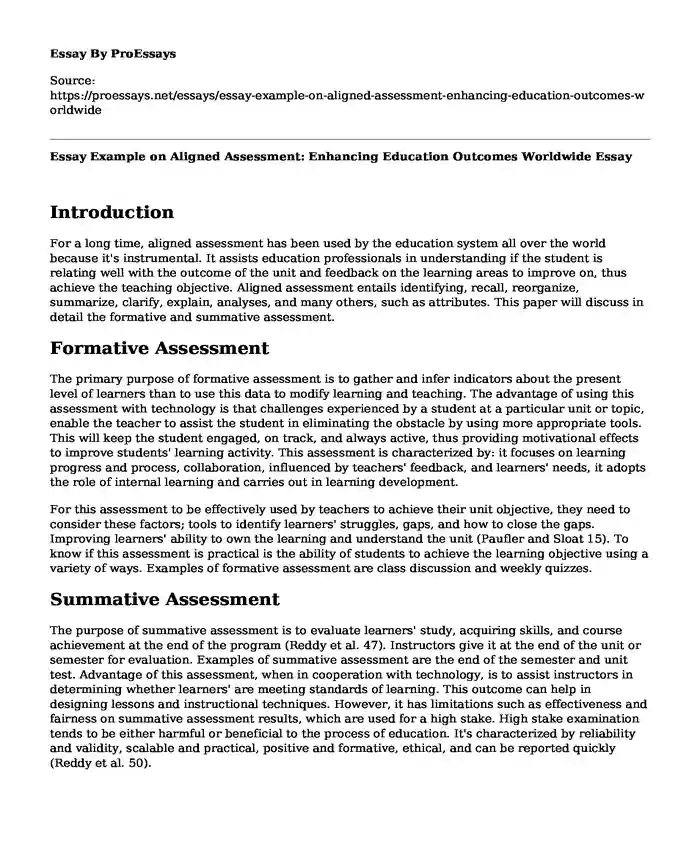Introduction
For a long time, aligned assessment has been used by the education system all over the world because it's instrumental. It assists education professionals in understanding if the student is relating well with the outcome of the unit and feedback on the learning areas to improve on, thus achieve the teaching objective. Aligned assessment entails identifying, recall, reorganize, summarize, clarify, explain, analyses, and many others, such as attributes. This paper will discuss in detail the formative and summative assessment.
Formative Assessment
The primary purpose of formative assessment is to gather and infer indicators about the present level of learners than to use this data to modify learning and teaching. The advantage of using this assessment with technology is that challenges experienced by a student at a particular unit or topic, enable the teacher to assist the student in eliminating the obstacle by using more appropriate tools. This will keep the student engaged, on track, and always active, thus providing motivational effects to improve students' learning activity. This assessment is characterized by: it focuses on learning progress and process, collaboration, influenced by teachers' feedback, and learners' needs, it adopts the role of internal learning and carries out in learning development.
For this assessment to be effectively used by teachers to achieve their unit objective, they need to consider these factors; tools to identify learners' struggles, gaps, and how to close the gaps. Improving learners' ability to own the learning and understand the unit (Paufler and Sloat 15). To know if this assessment is practical is the ability of students to achieve the learning objective using a variety of ways. Examples of formative assessment are class discussion and weekly quizzes.
Summative Assessment
The purpose of summative assessment is to evaluate learners' study, acquiring skills, and course achievement at the end of the program (Reddy et al. 47). Instructors give it at the end of the unit or semester for evaluation. Examples of summative assessment are the end of the semester and unit test. Advantage of this assessment, when in cooperation with technology, is to assist instructors in determining whether learners' are meeting standards of learning. This outcome can help in designing lessons and instructional techniques. However, it has limitations such as effectiveness and fairness on summative assessment results, which are used for a high stake. High stake examination tends to be either harmful or beneficial to the process of education. It's characterized by reliability and validity, scalable and practical, positive and formative, ethical, and can be reported quickly (Reddy et al. 50).
Conclusion
In conclusion, the formative assessment makes use of explicit criteria to define performance and encourage self-reflection strategy to students. Also, summative assessment uses rubric of specification, clearly designed questions, comprehensive assessment, establish clear parameters, and use of blind grading. In both evaluations, students should be involved while collecting data to be used in lesson planning, and effective means to set achievable goals and expectations at the end of the semester. Gathered data are used in this way for lesson planning, set individual academic goals using map assessment, apply intervention programs, evaluate curricula to target professional development, and differentiate individual instruction by learners' readiness. Summative assessment strategies are measured at the final level of a specific course or unit. Formative assessment cycle involves administer task, informed instructor knowledge, updated instruction and examining learners assignment
Works Cited
Paufler, Noelle A., and Edward F. Sloat. "Using standards to evaluate accountability policy in context: School administrator and teacher perceptions of a teacher evaluation system." Studies in Educational Evaluation, 2020. https://doi.org/10.1016/j.stueduc.2019.07.007
Reddy, Linda A., et al. "Teachers' and school administrators' attitudes and beliefs of teacher evaluation: A preliminary investigation of high poverty school districts." Educational Assessment, Evaluation, and Accountability, 2018. https://doi.org/10.1007/s11092-017-9263-3
Cite this page
Essay Example on Aligned Assessment: Enhancing Education Outcomes Worldwide. (2023, Sep 24). Retrieved from https://proessays.net/essays/essay-example-on-aligned-assessment-enhancing-education-outcomes-worldwide
If you are the original author of this essay and no longer wish to have it published on the ProEssays website, please click below to request its removal:
- Impact of School Resources on Learning Essay
- Is Ethical Concerns of Utilizing Social Media and Digital Platforms in Marketing to Children? - Paper Example
- Peer-To-Peer Mentorship Programs: Literature Review Paper Example
- Essay Example on Segregation in Schools: Children Fight for Equality and Liberty
- Reflective Teaching: Critical Thinking for Improved Outcomes - Essay Sample
- Big-Time Sports: College Sponsorship & Education Benefits - Paper Example
- Planning for Assessments - Essay Sample







